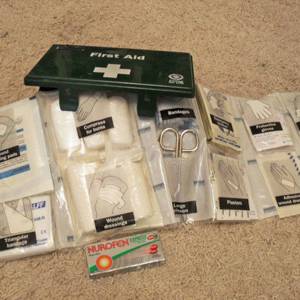
First Aid Kits – At Boatshedmedway.com
I am always in and around boats. My business is all about selling second hand boats. These range from small motor cruisers like the Bayliner Range to larger craft such as Fairline’s or a Pearl 55
Of late, on my travels across the Medway River in Kent, I have noticed that the days have started to lengthen and at times there is a bit of warmth in the sun, which might suggest that spring is on its way! Thus, we will all start to venture down to the yard or club to unwrap and prepare the boat. It’s only natural to concentrate on cleaning, painting and checking that everything is still working. However, may be there are a few things that might get overlooked because their preparation isn’t that necessary for getting the boat into the water. One of these items is probably the first aid kit. This is something that we hope to never actually use but also something that could be relied upon in an emergency. Therefore, for this year, I would suggest that you take the first aid kit home and spend a little time checking that it’s all in order.
In these days of the internet there is plenty of information and advice and a little bit of ‘surfing’ should get much, if not all the detail you need. The purpose of this article is not to give out detail on first aid itself or to provide an exact list of what is required. No, by reading this article I hope it makes you think about what you are taking on your trips and take action. Boating is fun but not without its risks. Thankfully for most people, the first aid kit is mostly for knocks, bruises and headaches (even after the night before!).
If first aid itself is an issue then there are plenty of good training courses that would be the basis of becoming familiar with this subject and perhaps the first ‘port of call’ in this instance should be the RYA who will have an extensive list of approved courses and books.
I suppose one of the starting points for the first aid kit, must be to determine where you are going to sail. If you consider that a medical relation within my family once advised Chay Blyth on the first aid kit that needed to be taken on a circumnavigation then I think you would agree that this is going to be very different to that which you might need for coastal cruising or short ‘hops’ across the channel etc.... So I suppose that the kit should be appropriate to the trip. If you are planning an extended cruise or circumnavigation then you should consult with an expert and be prepared to extend your equipment list beyond the standard. But for short holiday style cruises here is a brief list of items and things to consider:
1. A collection of items for dealing with cuts, bruises and abrasions etc.. These would include plasters, bandages, dressing pads, gauze and items that can be used as hot/cold packs. Cleaning liquids or antiseptic wipes to help stop the spread of infections. Consider the size of these items and the amount according to the average members of your crew. Most pharmacies will have packages that would be most suitable.
2. Fastenings including tape and safety pins.
3. Protective gloves. Always a nice reassuring addition especially if you are dealing with a stranger or somebody that you don’t know all that much.
4. A pair of scissors.
5. Sun creams for all the crew. Think about having different factors according to age ranges.
6. Consider that broken bones are a potential hazard and thus do you have enough bandages, blankets and items to hand that could be used to make a splint.
7. Some fairly standard mild medications to deal with headaches, pain relief, coughs/congestion remedies, antihistamines, and creams for sores. Also consider the age of your crew/passengers and have medications for children.
8. Consider how old certain items are and whether they are beyond a reasonable ‘use-by date’. Replace and update as necessary.
9. Where is the first aid kit to be located? Do all the crew know where it is and what is inside.
10. How is the first aid kit to be stored? Is it packaged away in a strong bag or sealed in a water proof/damage limiting container.
11. Familiarise your crew with all the means of contacting the emergency services and check that these are all in good working order.
Just a few thoughts and ideas to help prepare you and your boat for this new sailing season. This article should provoke some thought and action to go and dig out your first aid kit and give it a good check. If in doubt ‘trade it in’ for a replacement which can be found at most modern chandlers or via the internet.

